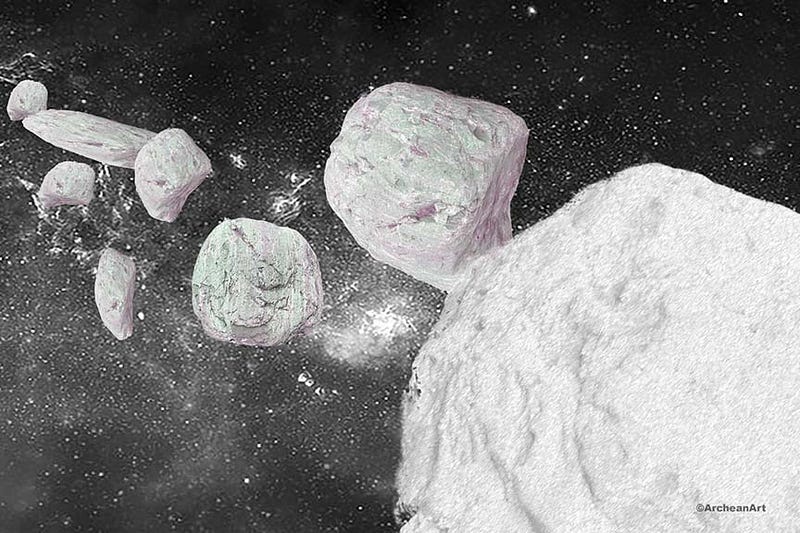Exploring Jupiter's Trojan Asteroids: Insights from Lucy Mission
Written on
Chapter 1: Understanding Lagrange Points
At a distance of 778 million kilometers from the Sun, two specific regions within Jupiter's orbit are home to countless wandering asteroids, many of which date back to the solar system's formation. Although these space rocks reside directly in Jupiter's path, the planet will never collide with them, as both travel around the Sun at identical speeds. The Trojan asteroids of Jupiter are located at 60-degree angles from the planet—one cluster ahead and one behind. These asteroids are ensnared in gravitational wells known as the L4 and L5 Lagrange points, which provide vital information regarding the solar system's origins. The Lucy spacecraft, launched on October 16, 2021, is on a 12-year mission to study these intriguing objects.
We are all somewhat aware of Lagrange points. For example, the James Webb Space Telescope is stationed at Earth’s L2 Lagrange point, situated on the planet's dark side, away from the Sun. This location is where the gravitational forces of Earth and the Sun counterbalance the centripetal force required for the telescope to maintain its position while orbiting the Sun. This equilibrium allows the telescope to conserve nearly all its internal power. In contrast, the Solar and Heliospheric Observatory (SOHO) operates from the L1 Lagrange point, approximately 1.5 million kilometers toward the Sun, where it also minimizes energy consumption. Meanwhile, Earth's L3 point, located on the far side of the Sun, often appears in science fiction as the setting for hidden planets or alien bases.
The first three Lagrange points are categorized as unstable. While small objects can occupy these “resting” spots, they would drift away without occasional adjustments, losing their alignment with Earth’s orbit. The first three points are intuitive because they lie in a straight line between Earth and the Sun. However, two additional points, L4 and L5, exist 60 degrees ahead of and behind Earth on its orbital path, respectively. These points are stable, creating localized gravitational wells that pull objects back when they drift away. Each planet generates its own set of Lagrange points through its interaction with the Sun.
Returning to Jupiter, its L4 and L5 regions are filled with thousands of asteroids that have likely been gathering there since the planet formed from cosmic debris. These asteroids are dubbed Trojan asteroids due to the naming convention established in the early 1900s by Austrian astronomer Johann Palisa. He named the first asteroids found in these regions after characters from the Trojan War as depicted in The Iliad. As more asteroids were discovered, it became customary to assign Greek names to L4 asteroids and Trojan names to those at L5.
The Lagrange points are localized and represent specific positions in space, whereas the stable zones are more expansive. Jupiter's Trojan asteroid belts are elongated, stretching nearly 400 million kilometers along their longest axis. For comparison, Earth is 150 million kilometers from the Sun.
A crucial aspect of Lagrange point calculations involves understanding how a small mass responds to the gravitational forces of two much larger bodies. The largest known Trojan asteroid, 624 Hector, measures 203 kilometers in diameter, but such large asteroids are uncommon; most are significantly smaller.
What are these asteroids composed of? This question remains largely unanswered until Lucy conducts close-up examinations in about four years. Current speculation suggests that many are low-density and rich in ice and organics, though there is evidence pointing to some potentially being metal-rich.
The Lucy mission aims to “explore a record-breaking number of asteroids, conducting flybys of one asteroid in the main belt and seven Trojan asteroids.” The spacecraft will reach several L4 Trojans in 2027 and one L5 asteroid in 2033, traveling at speeds exceeding 100,000 kilometers per hour.
The name Lucy is inspired by the fossilized remains of an early human ancestor found in Ethiopia in 1974. Legend has it that the night of the discovery, the celebrating paleoanthropologists played the Beatles' song “Lucy in the Sky with Diamonds,” and the name stuck.
Section 1.1: The Role of the Lucy Mission

The first video title is "Trojan Asteroids: Jupiter's Prisoners - YouTube," which delves into the fascinating nature of these asteroids and their unique characteristics.
The second video title is "Jupiter's Trojan Asteroids - YouTube," providing insights into the formation and significance of these celestial bodies.